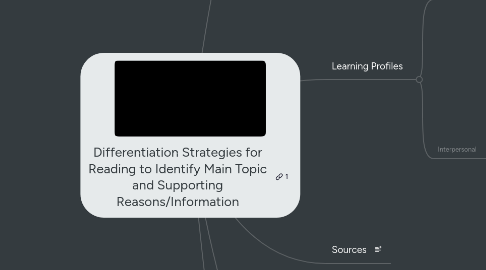
1. Readiness
1.1. Non-Native Speakers
1.1.1. With non-native speakers, it is helpful to use a lot of visuals to complement the topics discussed in class as well as use gestures to convey what you're discussing and the tone.
1.1.2. Teachers should also model activities before beginning them, and make sure that they are using the academic language students will need to use throughout the activity.
1.1.3. Teachers can also provide one-on-one additional support when it is needed to help with the understanding of the language used in the objective or the reading itself.
1.2. Gifted and Talented
1.2.1. Gifted and talented students tend to finish their work before other students so it is always good to have additional activities at hand that they can complete. However, it's good to make sure that they don't feel as if they have to do more work because they understand the material quickly. So it is good to provide games that they can complete with another student that is anchored in the main objective of the lesson. For example, a reading game of true and false questions.
1.2.2. Another option is to allow gifted and talented students to help others if they would like as this gives them the opportunity to rephrase what they have learned in their own words, developing their critical thinking skills, and may help another student that does not want to work one-on-one with the teacher.
2. Learning Profiles
2.1. Visual-Spatial
2.1.1. These learners think in terms of visuals and space. They learn more easily from reading maps, drawing, and doing things like jigsaw puzzles (in terms of teaching, graphic organizers can be a big help). For reading activities, I can help students with this type of learning by allowing them to draw the main topics and supporting reasons/information the way that they see it to help get a better understanding of the text.
2.1.2. I have also included a video game to help support this learning objective that ties the text to visuals and allows students to get a better idea of tone and mood while learning how to make clear and well supported arguments. http://www.quandarygame.org/
2.2. Interpersonal
2.2.1. These students learn through interaction and collaboration with their peers and teachers. A great way to ensure they are learning to the best of their ability is to do group work where students can discuss ideas with one another.
2.2.2. These students also benefit from attention from the teacher. The teacher can make a concerted effort to have small catch-up sessions with these students to see how they are doing with the material they are learning.
2.2.3. Integrating social media into lessons could also be very beneficial for these students, as it would allow them to chat with their peers about classwork outside of school.
3. Sources
4. Interests
4.1. Video Games
4.1.1. It's no surprise that a lot of our students like video games. So, why not incorporate them when you can? In the video game linked here, students address a lot of different elements of the overall standard (to eventually write a persuasive piece) and especially have to read for important information in this game. http://www.quandarygame.org/play
4.1.2. The teacher could also allow students to work in groups to develop their own games related to the topic. Even if they are unable to create a working video game, they could concept a game that would help other students learn about the main topic and supporting reasons/information.
4.2. Arts and Crafts
4.2.1. Some students find it easier to express themselves creatively, and a way to do that with this objective is to turn a persuasive writing text into a comic strip that illustrates the main idea of the text as well as the reasons and information supporting the main idea. Plus, as students already think of comics as a story, it will help introduce that the concluding statements are actually the ending.
4.2.2. Students could make a video that illustrates the main point and supporting facts in the form of a news story or play and show this to the class. This would allow them to make the background scenery and props needed for their program.

